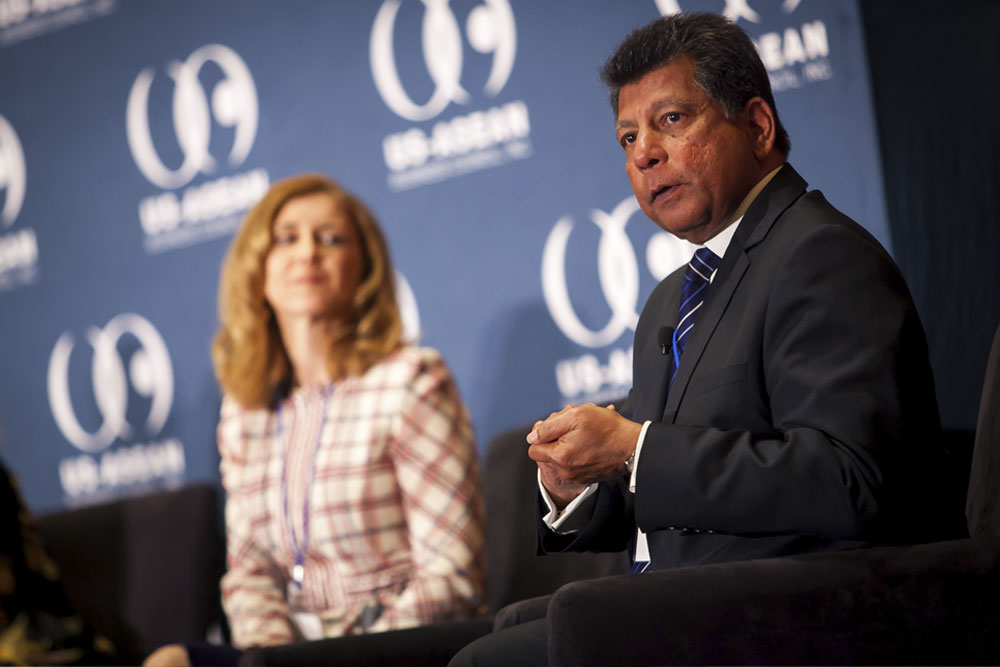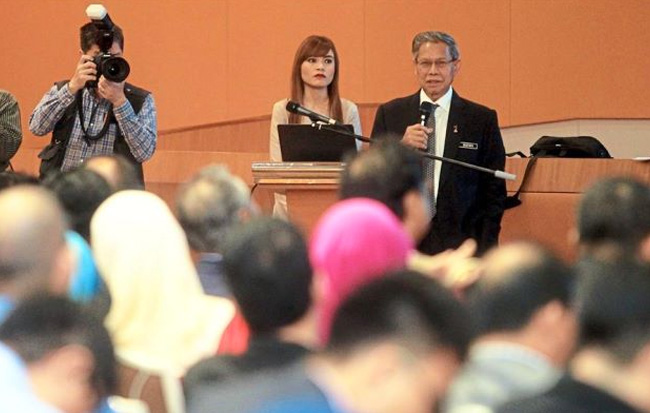13 February, 2016
As appeared in TheStar.com.my
I was in Vientiane earlier this month and, among other things, formally handed over the Chair of Asean-BAC to Laos, represented by Oudet Souvannavong. From the various meetings and discussions held, it was clear that Laos was committed to follow through with the AEC 2025 Blueprint and the unfinished business of the community pronounced in 2015, last year.
As a co-chair of Asean-BAC this year, I was asked by the Laotian Minister of Commerce and Industry Khemmani Pholsena to continue to be active in pushing forward the AEC agenda.
I indicated of course I would. Asean community-building is not a one-shot matter and every involved party must not be there just to make up the numbers.
After all, as I underlined in my speech at the second post-2015 AEC conference in Vientiane (I had organised the first in Penang last year), we must always improve as well as build on whatever good that has been achieved as we go along.
Last year, Asean-BAC achieved three main things which went beyond words and have strategic significance in respect of various AEC objectives.
The first was establishment of the Growth Accelerator Exchange (GAX) which I had proposed in lieu of the conventional Asean SME Bank to provide finance to the underserved sector which is the backbone of the Asean economy.
I got Asean-BAC to support me to champion this initiative which at one fell swoop achieves the following:
> Gets the private sector to do something about the long-standing problem of access to finance for micro and small and medium enterprises;
> While not a panacea, this form of digital banking would be catalytic as other private sector IT entrepreneurs will also want to get into the fray (I know Alibaba is straining at the leash to sweep into this market, but it would be good to see Asean entrepreneurs have a crack at it as well);
> Conventional banks will not want to see their revenue base shrink and the more nimble will simultaneously expand commitments to the SME sector as well as their digital banking arm (it is generally estimated that digital banking will come to comprise 30% of total banking industry revenues);
> Micro businesses and SMEs will not only gain better access to finance but will, at the same time, obtain it by digital means including through use of smartphones – thus hurdling over the need for brick and mortar bank branches which are absent to fulfill their requirements, and at lower and more competitive cost;
> Apart from e-finance, such electronic platforms can also integrate e-payments and e-logistics which will expand the reach and possibilities for SMEs in terms of both B2B and B2C linkages;
> Asean member states have the opportunity, in real terms, to address at least in part frequently stated strategic concerns: the development gap as SMEs are given the opportunity to expand, especially in the CLMV (Cambodia, Laos, Myanmar and Vietnam) countries where almost the whole of the economies are comprised of such enterprises; and the digital divide, as use of technology in gaining access to finance and the growth of businesses, expands in less developed Asean countries;
> Asean member states will be challenged to facilitate, on a problem-solving basis, issues that could hinder digital access to finance in the neediest segments of their economies, such as e-payments arrangements and cross-border collateral recognition and enforceability – otherwise they would be shown to be only paying lip-service to wanting to close the development gap, the digital divide and so on;
> most strategic of all, development of the micro and SMEs will ensure the success and further progress of the AEC, as there will be less likelihood of backsliding and reversal from loss of employment in the sector – if neglected – which overwhelmingly absorbs most of the working population of the Asean economy.
Thus GAX has within it the seeds of actualizing so many AEC objectives, important words but recorded on paper. The private sector should look at more project driven initiatives that bring strategic benefit in their wake.
The second achievement of Asean-BAC last year was the setting up of AYEC (Asean Young Entrepreneurs Council), with the AYEA (Asean Young Entrepreneurs Association) due to be established by the end of this year.
This is important because the 65% of the Asean population who are under 35 and are entrepreneurs should have a voice all their own to express their ambitions and concerns, and to offer their solutions.
It is often said that Asean would reap the demographic dividend because of the youthfulness of its population.
However, optimal outcomes, whether on the demand or supply side, can only be achieved if this constituency are released and encouraged to play their full part in the economy.
Especially on the supply side, young and innovative entrepreneurs will only realize their potential if their abilities gain full expression.
Through the AYEA, they should have dialogues with Asean leaders and ministers and, importantly, with relevant Asean committees and working groups, especially on IT, e-commerce and the new economy.
They are well ahead of the greying business leaders who have come to dominate, after years of good service mind you, Asean private sector representative bodies like Asean-BAC itself.
This does not mean that wisdom should be eschewed – as indeed evidenced by how Asean-BAC “incubated” AYEC, but the combination is needed between experience and youthful dynamism.
It is interesting to note that among the discussions likely to take place in the Sunnylands Summit between Asean and the US next Monday and Tuesday will be a session on promoting regional prosperity through innovation and entrepreneurship.
President Obama has been very keen on the YSEALI (Young South-East Asia Leaders Initiative) programme, and there is no better way to elevate Asean relations with the US from dialogue to strategic partner than through engaging young entrepreneurs and innovative leaders of tomorrow.
Indeed, from a Malaysian perspective, there will be a delegation of young entrepreneurs and business leaders visiting Silicon Valley just after the Sunnylands Summit, organised by the Malaysia America Foundation vice-president Syed Haizam.
This reaching out for linkages is a test of how actually and progressively strategic the relationship with the US is going to be.
These leaders of tomorrow should, together with their Asean brethren, form a dynamic caucus of young regional entrepreneurial leadership through the AYEA. How dynamic depends on how the AYEA is organised and represented.
But one thing is for sure. Being young, with many years ahead of them, not only will they drive the AEC into the future but also their socialisation will give Asean a bedrock for the realisation of a true community.
Finally, I argued hard through Asean-BAC last year on the need for a better structured and more rigorous collaboration between the official and private sectors. And I am so pleased the officials, ministers and leaders have responded positively. In the AEC 2025 Blueprint it is stated explicitly that such cooperation should be forged. There is an onus placed on Asean-BAC to be more effective and to organize this.
While Asean-BAC must deliver, it is nevertheless real progress that there is this recognition of the need for a collaboration of substance and not just dialogues of form.
In Laos this month, Asean Deputy Secretary General Lim Hong Hin held a discussion with Asean-BAC on how to fashion this cooperation. If Asean-BAC gets its act together, I have every confidence, through the secretariat, private sector representation and participation in strategic committees and working groups can be worked out.
It is however not just Asean-BAC that must get its act together.
All the Asean+1 Business Councils must also cooperate, as must all Asean-focused organisations and expert groups, such as those in the healthcare and agri-food and e-commerce sectors.
It is important for the secretariat to share drafts. For the private sector to understand the need for confidentiality as well as to make positive inputs.
The first order of business is to identify the relevant committee and working groups with the assistance of the secretariat.
For example, while the private sector has been vocal on elimination of non-tariff measures, it is less aware this is best addressed at the Coordinating Committee on ATIGA (Asean Trade in Goods Agreement). There is work to be done.
The deliverables for Laos this year, in form of words, are the following:
> Asean Trade Facilitation
> Asean Regulatory Framework for Food Safety
> Asean Framework on Financial Inclusion
> Enabling environment for SME establishment and development
> Vientiane Declaration on Ecotourism
> Asean Sustainable Tourism Award
> Framework for secretariat development and collaboration
> Masterplan for CLMV development
Asean-BAC’s plan for taking action out of words this year is to establish a logistics link from China through Laos down to Singapore, in the context of the Masterplan for CLMV development, using Laos’ focal CLMV position.
It will be another test of implementation of policy.
Tan Sri Dr Munir Majid, chairman of Bank Muamalat and visiting senior fellow at LSE Ideas (Centre for International Affairs, Diplomacy and Strategy), is also chairman of CIMB Asean Research Institute.









